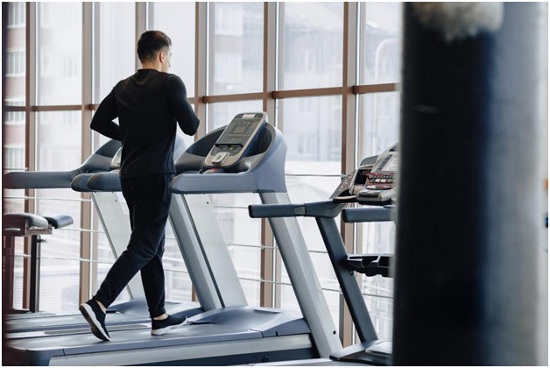Introduction
In the ever-evolving world of fitness, innovation is key to keeping workouts exciting and effective. One such innovation is incline training on treadmills, a dynamic approach that has gained significant popularity in recent years. In this article, we will delve into the top five benefits of incline training on treadmills in 2023, exploring how this trend is shaping the future of fitness.


What Is Incline Training, Exactly?
Incline training, also known as hill training, involves the act of walking or running on an inclined surface, creating an environment that replicates ascending a hill. This method of training challenges individuals by introducing an upward incline, and while most commonly associated with treadmills, it can be performed in various settings, including hiking trails, ski mountains, ellipticals, and stationary bikes.
Incline training unquestionably presents a greater level of difficulty compared to cardio workouts on level surfaces which has numerous health benefits. It necessitates heightened effort and power from your lower body muscles and cardiovascular system, regardless of your chosen pace or whether you opt for low-impact aerobic exercise or engage in the intensity of a HIIT (High-Intensity Interval Training) treadmill session. The following sections will shed light on the remarkable benefits of incline training, explaining why it has garnered such popularity in the fitness world in recent years.
Benefit 1: Enhanced Cardiovascular Endurance
- Increased Caloric Burn: Incline training dramatically intensifies your workout, leading to a higher calorie burn rate compared to running on a flat surface. You can expect to torch calories at a faster rate, making it an excellent choice for weight management and fat loss.
- Improved Heart Health: Regular incline treadmill training strengthens your heart by challenging it to pump more blood against gravity. Over time, this leads to enhanced cardiovascular endurance, lower resting heart rate, and reduced risk of heart-related issues.
- Greater Lung Capacity: The elevation simulates high-altitude conditions, prompting your lungs to work harder. This results in improved lung capacity and oxygen utilization, enabling you to breathe more efficiently during both exercise and daily life.
Benefit 2: Muscle Engagement and Toning
- Lower Body Strength: Incline training engages more muscles in your lower body, especially the glutes, quads, and calves. This leads to better muscle definition and increased leg strength.
- Core Activation: Maintaining balance while training on an inclined treadmill requires core stabilization, which, over time, leads to a stronger and more toned midsection.
- Reduced Impact on Joints: Incline training reduces the impact on your joints compared to running on concrete or pavement. This makes it a safer option for those with joint concerns, while still providing an excellent lower body workout.


Benefit 3: Variability for Versatility
- Endless Workout Possibilities: Incline training offers versatility and a plethora of workout options. You can vary the incline level, speed, and even incorporate interval training for a well-rounded workout experience.
- Targeted Muscle Focus: Adjusting the incline allows you to focus on specific muscle groups. A steeper incline can target the glutes and hamstrings, while a moderate incline provides an excellent cardiovascular workout.
- Increased Motivation: The diversity in your workout routine keeps you engaged and motivated. You’ll look forward to each session, and this consistency will ultimately lead to better results.
Benefit 4: Improved Posture and Balance
- Enhanced Postural Awareness: Walking or running on an incline forces you to maintain proper posture, which, when practiced regularly, translates into better posture throughout your daily life.
- Balance and Coordination: The constant adjustment to the incline level enhances your balance and coordination. This is particularly beneficial for older adults looking to maintain their agility and prevent falls.
- Reduced Risk of Overuse Injuries: Incline training reduces the risk of overuse injuries common in flat-surface running by distributing the impact more evenly across various muscle groups.
Benefit 5: Mental Health and Mindfulness
- Stress Reduction: Incline training offers a chance to escape the daily grind and immerse yourself in a focused, challenging activity. This can help reduce stress and improve overall mental well-being.
- Mindful Exercise: The concentrated effort required during incline training promotes mindfulness, as you pay closer attention to your movements, breathing, and body. This can foster a sense of mindfulness and relaxation.
- Achievement and Confidence: As you conquer steeper inclines and see improvements in your fitness levels, you’ll gain a sense of achievement and boost your self-confidence, both in the gym and in your daily life.
Conclusion
Incline training on treadmills has firmly established itself as a fitness trend that’s here to stay in 2023 and beyond. The benefits are abundant, from enhanced cardiovascular endurance and muscle toning to improved posture and mental well-being. As you incorporate incline training into your fitness routine, remember that consistency and gradual progression are key. Whether you’re a seasoned fitness enthusiast or just starting your fitness journey, the incline treadmill offers something for everyone, promising a healthier, more active lifestyle and the opportunity to reach new heights in your fitness goals.
Frequently Asked Questions (FAQs)
1. Is incline training suitable for beginners?
Yes, incline training can be adapted to suit beginners. Start with a gentle incline and lower speeds, gradually increasing the intensity as you become more comfortable and conditioned.
2. What’s the ideal incline level for a good workout?
The ideal incline level varies depending on your fitness goals. For a cardiovascular workout, a 3-5% incline is effective. If you want to target specific muscles or increase the intensity, consider higher incline levels, up to 15%.
3. Can I replace flat-surface running with incline training entirely?
While incline training offers many benefits, it’s recommended to include a variety of workouts in your routine. Incorporating both flat-surface and incline training provides a balanced approach to fitness.
4. Are there any safety considerations for incline training?
Yes, safety is important. Always start with a warm-up and cool-down, and ensure that your treadmill is stable and secure. It’s advisable to use the safety clip or strap provided with your treadmill.
5. Can incline training help with weight loss?
Yes, incline training is an effective tool for weight loss. The increased calorie burn and muscle engagement make it an excellent choice for individuals looking to shed excess pounds.
6. How often should I include incline training in my workout routine?
The frequency of incline training depends on your fitness goals. For general fitness, 2-3 sessions per week can be effective. However, always listen to your body and allow for adequate recovery time.

























